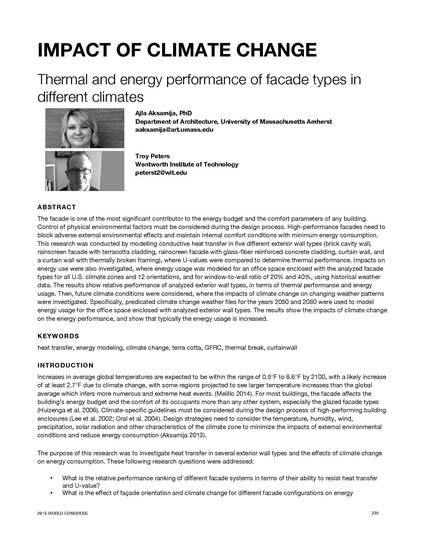
Article
Impact of Climate Change: Thermal and Energy Performance of Facade Types in Different Climates
Facade World Congress
(2016)
Abstract
The facade is one of the most significant contributors to the energy budget and the comfort parameters of any building. Control of physical environmental factors must be considered during the design process. High-performance facades need to block adverse external environmental effects and maintain internal comfort conditions with minimum energy consumption. This research was conducted by modelling conductive heat transfer in five different exterior wall types (brick cavity wall, rainscreen facade with terracotta cladding, rainscreen facade with glass-fiber reinforced concrete cladding, curtain wall, and a curtain wall with thermally broken framing), where U-values were compared to determine thermal performance. Impacts on energy use were also investigated, where energy usage was modeled for an office space enclosed with the analyzed facade types for all U.S. climate zones and 12 orientations, and for window-to-wall ratio of 20% and 40%, using historical weather data. The results show relative performance of analyzed exterior wall types, in terms of thermal performance and energy usage. Then, future climate conditions are considered, where the impacts of climate change on changing weather patterns were investigated. Specifically, predicated climate change weather files for the years 2050 and 2080 were used to model energy usage for the office space enclosed with analyzed exterior wall types. The results show the impacts of climate change on the energy performance, and show that typically the energy usage is increased.
Keywords
- high-performance facades,
- simulations,
- heat transfer,
- energy modeling,
- climate change
Disciplines
Publication Date
2016
Citation Information
Ajla Aksamija and Troy Peters. "Impact of Climate Change: Thermal and Energy Performance of Facade Types in Different Climates" Facade World Congress (2016) p. 235 - 244 Available at: http://works.bepress.com/ajla_aksamija/116/
